The temples on the sacred rock of the Acropolis, built at the end of the fifth century BC, are some of the world’s most important buildings. They would influence the architecture of the Western World for more than two millennia.
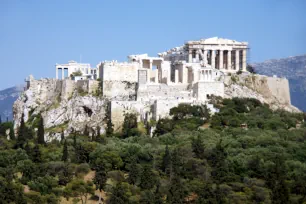
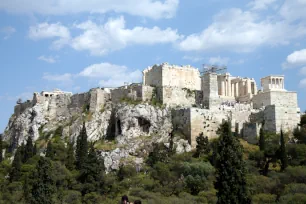
The word acropolis means “highest point”. Most Greek cities had their acropolis, where people sheltered during wartimes and where they built their sanctuaries. Today, the term refers specifically to the Acropolis in Athens, a 156 meter (512 ft) high limestone rock. Here Athenians built magnificent temples, most of them dedicated to the goddess Athena, patroness of the city.
Acropolis Timeline
The Acropolis as we know it dates back to the fifth century BC, when the city was at the peak of its power. The hill itself, however, is known to have been inhabited much earlier, and excavations have revealed traces of settlement dating back to the Neolithic Age, six millennia ago. In the thirteenth century BC, the Mycenaeans built a royal palace here, which was surrounded by a fortification wall, portions of which still remain.
The first temples dedicated to Athena were built in the eighth century BC, during the Archaic Era. About 150 years later, the city’s largest religious festival, the Panathenaia, was established, and the first monumental buildings began appearing atop the hill, including the “Old Temple” and the Hekatompedos, both dedicated to Athena as well.
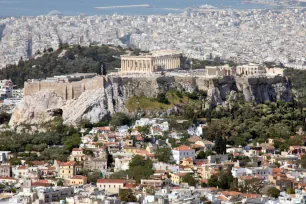
In 480 BC the Persians destroyed all the buildings on the Acropolis. Some parts of the ruined Athenian temples were incorporated into the northern wall and are visible today.
After the defeat of the Persians in 479 BC, Pericles initiated a huge building project at the Acropolis, lasting more than fifty years. The Parthenon, the Propylaea, the Erechtheion, and the temple of Athena Nike, all of which still exist, were erected during this period by those who were considered the greatest architects, sculptors and artists of their time.
No other important buildings were erected here until the first century BC, during the Roman Era, when a small circular temple dedicated to Augustus and Rome was built east of the Parthenon.
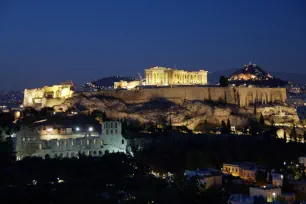
In the sixth century AD, after the fall of the Roman Empire, the temples were converted into Christian churches. The largest temple, the Parthenon, was dedicated to the Virgin Mary and served as the city’s cathedral in the eleventh century. The Propylaea served as a residence during the Ottoman period, when the Parthenon was used as an arsenal.
The Venetians destroyed the Parthenon in 1687 and its sculptural decoration was looted during the early nineteenth century. It wasn’t until the Acropolis and its buildings came under the care of the new Greek state in 1822 that priority was given to preserving the area. Large scale renovation projects began in 1975 and still continue to this day.
Buildings on the Acropolis
Propylaea
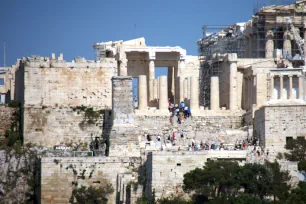
The Propylaea – the monumental gateway to the Acropolis – was built in the fifth century BC on the west side of the Acropolis. The Propylaea replaced the Propylon, a smaller entrance gate built here a century earlier, during the reign of Peisistratos.
Construction started in 437 BC and lasted until 432 BC, when work was halted due to the threat of the Peloponnesian War, which started the following year. The Propylaea consisted of a large, temple-like central building flanked by two wings. The fronts of the central building had pediments supported by Doric columns. Inside were six Ionic columns. There were five gates that allowed entrance to the Acropolis; the largest, central one was more than 4 meters wide and almost 7.5 meters high (25 ft).
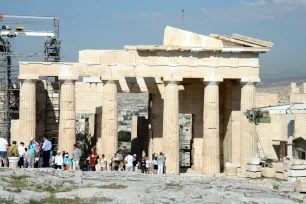
The north wing, a large rectangular building, was known as the Pinakotheke. It was used to display paintings. The south wing was much smaller and built as an open gallery.
Originally, a twenty-meter-wide (66 ft) ramp led from the foot of the Acropolis to the Propylaea. In the first century AD, the Romans replaced it with a monumental staircase. After the invasion of the Heruli tribe in 267 AD, a new gate was built in front of the Propylaea. The gate is known as the Beulé-gate, after the French archaeologist who discovered it in 1852.
Temple of Athena Nike
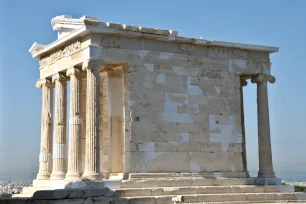
In front of the south wing of the Propylaea stands the Temple of Athena Nike, dedicated to the goddess of Victory. It is a small temple built in 421 BC, during a pause in the Peloponnesian War. The temple was designed by Kallikrates, who had also worked on the Parthenon. The temple has four Ionic columns on the east and north side, each 4.66 meters tall (15 ft). It is decorated with a frieze that depicts scenes from the Battle of Plataea, where Greek armies defeated the Persians. The temple was demolished in 1687 by the Ottomans, but it was reconstructed between 1834 and 1838 when the original materials were discovered.
Parthenon
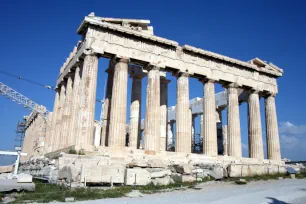
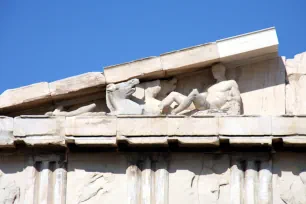
The most important temple on the Acropolis was the Parthenon, built between 447 and 438 BC. The temple was almost seventy meters long and thirty-one meters wide (230 x 100 ft). Forty-six columns surrounded the inner cellae, one of which housed an enormous statue of goddess Athena, to whom the temple was dedicated. The pediments were decorated with magnificent sculptures – about fifty in total – and large friezes adorned the temple. Many of these were chiseled off in the early nineteenth century by Lord Byron and transported to the United Kingdom and eventually displayed in the British Museum in London.
The majority of the sculptures that once decorated the Parthenon are still in the British Museum, the rest is on display at the Acropolis Museum.
Erechtheion
The Erechtheion or Erechtheum was erected between 421 and 406 BC at the most sacred place of the Acropolis. This is where the gods Poseidon and Athena battled for the right to be patron deity of the city. Each would give the city a gift, and then the people could decide which gift they preferred.
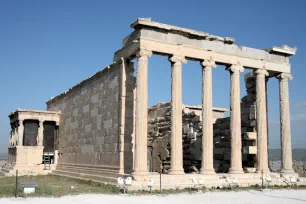
Poseidon planted his trident in the rock, creating a salt spring. Athena planted an Olive tree. Since the water from the spring was salty, the Athenians chose the Olive tree, which they could harvest and as a result Athena became the patron deity of Athens.
The temple was named for Erechtheus, a mythical king of Athens, and was dedicated to both Poseidon and Athena. Construction of the building started in 421 BC, and it was completed fifteen years later. Inside the temple’s cella stood an ancient, wooden statue of Athena which, according to legend, had fallen from the sky.
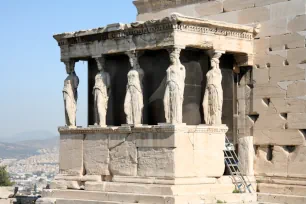
Three porticos led to the inner chambers of the cella. The most famous is the iconic porch of the Korai, better known as the porch of the Caryatids. Here, the Ionic columns are replaced with statues of young girls. In their hands they held plates, now lost. The statues on the Acropolis have been replaced by replicas. Five of the original six statues are in the Acropolis Museum, the remaining one is on display at the British Museum.
Other Buildings
There were several other sanctuaries on the Acropolis, but only traces of these buildings remains. The most important of these were the Arrephorion – a small square building, the Chalkotheke or Bronze Gallery where bronze offerings to Athena were kept, the stoa of Artemis Brauronia and two smaller sanctuaries dedicated to Zeus Polieus and Pandion, a mythical king of Athens.
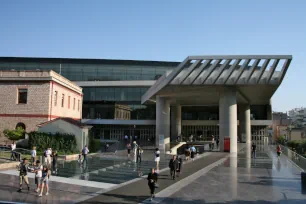
There were also statues on the Acropolis, the most important of which was a nine meter (30 ft) tall bronze statue of Athena, created by Pheidias.
Acropolis Museum
Until 2009 the many statues and artifacts that were found on the Acropolis were displayed in a nineteenth century building on the Acropolis, just west of the Parthenon. Today the magnificent collection is housed in the modern Acropolis Museum, at the foot of the Acropolis. Highlights are a collection of Archaic statues, reliefs and sculptures from the Parthenon and the original caryatids of the Erechtheion.
- Next: Parthenon
- More Sights & Attractions in Athens
